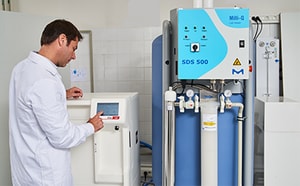IVD Manufacturing

In vitro diagnostics (IVD) involves testing samples, such as tissue or blood, to detect diseases or other conditions using sensitive tests. IVD can be used to monitor a person’s general health and to aid in the treatment or prevention of diseases.
Featured Categories
From a single lab to an entire building, Milli-Q® central water purification systems are connected, high-performance instruments that can reliably feed all purified water needs.
Milli-Q® systems offer innovative water purification technologies engineered to support lab research needs, sustainability goals, and other major requirements.
Our customized portfolio of high-quality critical raw materials for API synthesis supplies the solvents, reagents, documentation, and expertise you need to meet stringent regulatory requirements and mitigate risk in all aspects of small molecule drug development and manufacturing.
IVD Assay Types
Most in vitro diagnostic assays are developed based on molecular or immunodetection technologies, including polymerase chain reaction (PCR), enzyme-linked immunosorbent assays (ELISA), chemiluminescent immunoassays (CLIA), lateral flow, cytology, and immunohistochemistry. PCR and its variants are specific and sensitive detection methods used to identify and amplify unique stretches of DNA/RNA indicative of a pathogen or disease state.
In ELISA-based assays, antibodies are attached to a chromogenic enzyme, which in the presence of substrate produces a quantitative, colorimetric signal. In CLIA, an enzyme converts a substrate into a chemiluminescent signal that is emitted as visible or near visible light. The amount of light produced directly correlates to the quantity of target analyte present in the sample. Lateral flow test strips are routinely used to detect certain target components in liquid samples. Based on basic immunochromatography principles, a complex is formed between a detector particle in the sample stream and a capture reagent bound at the test line. Certain staining assays use antibodies and specific stains to identify and localize cells which are indicative of a disease state. These assays are widely used in cytology, hematology, blood typing, and histopathology.
IVD Development and Scale Up
Developing a diagnostic assay from the design stage through product development and final manufacturing employs principles from biology, chemistry, physics and engineering. There is no guarantee that an assay with the required clinical sensitivity and specificity developed within the R&D environment will be transferrable to production scale. An assay that works reliably on the bench top often requires further development and reagent reformulations, when moved to scale-up. Experienced diagnostic assay developers leverage key fit-for-use materials aligned with regulatory requirements and supply-chain security, to save significant time and cost by minimizing variations. The process from the discovery of a promising assay to a marketable IVD kit approved by regulatory authorities may take two years or more to complete.
IVD Manufacturing
Upon the successful transition of a diagnostic assay to full-scale production, the developer’s emphasis shifts to monitoring and controlling the quality of components and assembly. Supply chain management becomes critical and risk mitigation strategies are devised to ensure business continuity in the event of manufacturing disruptions. Quality management systems (QMS) and careful documentation of production processes according to ISO and other regulatory guidelines keep the final assay product compliant and sellable. Governing bodies conduct scheduled and unscheduled audits of all IVD manufacturing facilities to verify safety and quality compliance.
IVD Contract Manufacturing Outsourcing
IVD manufacturing is a valid strategic decision due to the significant capital expenditure required for in-house manufacturing. In addition to the costs of equipment, there is also the need to develop a Quality Management System (QMS) aligned with all regulatory requirements, the hiring of personnel, and the acquisition of the appropriate certifications. Due to the significant capital expenditure required, many companies choose outsourcing in order to redeploy their capital towards growing their business and developing new products. Considerations for successful assay launch through contract manufacturing include your partnership’s ability to master supply-chain management, assay scale-up to manufacture, and regulatory compliance.
Visit our document search for data sheets, certificates and technical documentation.
Related Articles
- Choosing lateral flow pad materials is critical to the success of the test. Pads comprise the porous matrices that are used for the sample pad, conjugate pad, and absorbent pad.
- Steven J. Oldenburg, Ph.D. provides an overview of lateral flow diagnostic assays and discusses the use of ultra-bright reporter particles based on the unique optical properties of gold nanoshells that significantly increase the sensitivity of lateral flow immunoassays.
- Fit-for-use products offer the quality, consistency & documentation necessary for every step of your IVD development and manufacturing process.
- Cell based assays for cell proliferation (BrdU, MTT, WST1), cell viability and cytotoxicity experiments for applications in cancer, neuroscience and stem cell research.
- Available Fluorescent in situ hybridization (FISH) procedures, reagents and equipment.
- See All (26)
Related Protocols
- Learn standard PCR protocol steps and review reagent lists or cycling parameters. This method for routine PCR amplification of DNA uses standard Taq DNA polymerase.
- Annealing is the process of heating and cooling two single-stranded oligonucleotides with complementary sequences.
- These tables will help you navigate the preparation of many common buffer solutions by pH and pKa. Choose a buffer with an effective pH range for your specific assay.
- Learn about Sanger Sequencing steps or the chain termination method and how DNA sequencing works and how to read Sanger Sequencing results accurately for your research.
- Our SYBR Green qPCR Protocol is a method designed to detect accurate quantification of gene expression and RT-PCR reactions
- See All (2)
Find More Articles and Protocols
How Can We Help
In case of any questions, please submit a customer support request
or talk to our customer service team:
Email custserv@sial.com
or call +1 (800) 244-1173
Additional Support
- Calculators & Apps
Web Toolbox - science research tools and resources for analytical chemistry, life science, chemical synthesis and materials science.
- Customer Support Request
Customer support including help with orders, products, accounts, and website technical issues.
- FAQ
Explore our Frequently Asked Questions for answers to commonly asked questions about our products and services.
To continue reading please sign in or create an account.
Don't Have An Account?


